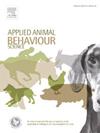小心处理:在常规检查中,狗对限制性处理约束和工具表现出负面反应
IF 2.2
2区 农林科学
Q1 AGRICULTURE, DAIRY & ANIMAL SCIENCE
引用次数: 0
摘要
定期看兽医对监察狗只的健康状况很重要;然而,在身体检查期间的处理可能会引起狗的恐惧反应。虽然存在处理建议以减轻狗的负面经历,但很少有经验证据支持这些处理建议。因此,本研究旨在探讨处理技术和工具对狗在常规兽医检查中的行为和生理反应的影响。共有97只狗从当地的市政收容所招募。采用平衡年龄(平均年龄为3.5岁)、性别(雌性49只,雄性48只)和体型(小型40只,中型/大型57只)的随机区组设计,将犬随机分为5种处理:1)被动约束、2)套口约束、3)篮型口套、4)软口套和5)全身约束。进行接近意愿测试以评估对处理者的社交能力,随后进行处理阶段(处理治疗期间进行2分钟检查)和处理后阶段(30秒观察期)。在处理和处理后阶段测量行为反应(姿势减少、舔嘴唇、打哈欠、发声、消除、身体颤抖、颤抖、回避、逃跑),并记录处理过程中的生理反应(体温、呼吸和心率)。在每个阶段,还使用5项量表来评估用于测量恐惧的量表(0 =无恐惧,4 =极度恐惧)。结果表明,在不同的处理中,大多数狗在处理过程中姿势减少(63 %,61/97),处理后姿势中性(95 %,92/97)。在处理过程中,与被动约束的狗相比,接受口套约束的狗表现出更多的逃跑企图(p = 0.009),而接受全身约束的狗表现出更多的发声(p = 0.008)。与被动约束相比,将狗放在软口套(p = 0.001)和篮口套(p lt;0.001)中所需的时间更长。与被动约束的狗相比,软口吻的狗更有可能表现出回避行为(p<0.001)。不同治疗组的生理指标无差异。与所有其他治疗方法相比,被动约束的恐惧得分较低:持口(p=0.001),篮式枪口(p=0.0157),软枪口(p=0.0001)和全身约束(p=0.0001)。结果表明,与被动约束和使用枪口工具相比,狗在使用枪口和全身约束时表现出更多的负面反应。该研究可用于提供基于证据的建议,并支持实施较少限制性的处理,以减轻犬在常规检查期间的压力。本文章由计算机程序翻译,如有差异,请以英文原文为准。
Handle with care: Dogs show negative responses to restrictive handling restraints and tools during routine examinations
Routine veterinary visits are important for monitoring dog welfare; however, handling during physical examinations may elicit fear responses in dogs. Although handling recommendations exist to mitigate negative experiences for dogs, there is little empirical evidence to support these handling recommendations. Thus, this study aimed to investigate the influence of handling techniques and tools on dog behavioral and physiological responses during routine veterinary examinations. A total of 97 dogs were recruited from a local municipal shelter. Using a randomized block design balanced for age (mean age was 3.5), sex (49 female, 48 male), and size (40 small, 57 medium/large), dogs were randomly sorted into one of five treatments: 1) passive restraint, 2) muzzle-hold restraint, 3) basket muzzle, 4) soft muzzle, and 5) full-body restraint. A willingness-to-approach test was conducted to assess sociability toward the handler, followed by a handling phase (2-minute examination while in the handling treatment), and a post-handling phase (30-second observation period). Behavioral responses (posture reductions, lip licking, yawning, vocalizing, elimination, body shaking, trembling, avoidance, escape) were measured during the handling and post-handling phases, and physiological responses (temperature, respiratory and heart rate) were recorded during handling. A scale used to measure fear was also assessed during each phase using a 5-item scale (0 =no fear, 4 =extreme fear). Results indicated that across treatments, most dogs showed reduced posture during handling (63 %, 61/97), and neutral posture post-handling (95 %, 92/97). During handling, dogs in the muzzle-hold restraint displayed more escape attempts (p = 0.009) and dogs that received the full-body restraint performed more vocalizations (p = 0.008) compared to dogs in the passive restraint. It took longer to place dogs in the soft (p = 0.001) and basket muzzle (p<0.001) compared to the passive restraint. Dogs in the soft muzzle were more likely to display avoidance behaviors (p<0.001) than dogs in passive restraint. Physiological measurements did not vary by treatment group. Fear scores were lower during handling in passive restraint compared to all other treatments: muzzle-hold (p=0.001), basket muzzle (p=0.0157), soft muzzle (p=0.0001), and full-body restraint (p=0.0001). Results suggest that dogs display more negative responses when handled with the muzzle-hold and full-body restraints, compared to passive restraint and use of muzzle tools. This study can be used to inform evidence-based recommendations and support the implementation of less restrictive handling to mitigate stress for dogs during routine examinations.
求助全文
通过发布文献求助,成功后即可免费获取论文全文。
去求助
来源期刊

Applied Animal Behaviour Science
农林科学-行为科学
CiteScore
4.40
自引率
21.70%
发文量
191
审稿时长
18.1 weeks
期刊介绍:
This journal publishes relevant information on the behaviour of domesticated and utilized animals.
Topics covered include:
-Behaviour of farm, zoo and laboratory animals in relation to animal management and welfare
-Behaviour of companion animals in relation to behavioural problems, for example, in relation to the training of dogs for different purposes, in relation to behavioural problems
-Studies of the behaviour of wild animals when these studies are relevant from an applied perspective, for example in relation to wildlife management, pest management or nature conservation
-Methodological studies within relevant fields
The principal subjects are farm, companion and laboratory animals, including, of course, poultry. The journal also deals with the following animal subjects:
-Those involved in any farming system, e.g. deer, rabbits and fur-bearing animals
-Those in ANY form of confinement, e.g. zoos, safari parks and other forms of display
-Feral animals, and any animal species which impinge on farming operations, e.g. as causes of loss or damage
-Species used for hunting, recreation etc. may also be considered as acceptable subjects in some instances
-Laboratory animals, if the material relates to their behavioural requirements
 求助内容:
求助内容: 应助结果提醒方式:
应助结果提醒方式:


